Beyond the Headlines Part 1: Methane
You've probably heard it in the news: "Meat production is a leading contributor to climate change." But is it really that simple? At Modern Pastures, we believe in sharing balanced, evidence-based information about livestock agriculture and its environmental impact. Let's dive into the science of greenhouse gases and ruminant agriculture in a way that goes beyond the oversimplified headlines.
The Complexity Behind Carbon Equivalents
When we talk about climate change, we often lump all greenhouse gases (GHGs) together under the term "carbon footprint." While this makes for convenient headlines, it overlooks a crucial scientific reality: not all greenhouse gases behave the same way in our atmosphere.
The three main greenhouse gases associated with agriculture are carbon dioxide (CO₂), methane (CH₄), and nitrous oxide (N₂O). Each of these gases has different atmospheric behaviors and lifespans, but they're typically converted to "CO₂ equivalents" using a metric called GWP₁₀₀, or Global Warming Potential over 100 years.
Under this standard conversion, methane is considered 28 times more potent than CO₂. This single number has shaped much of the conversation around livestock and climate change, since ruminant animals like cattle produce methane as part of their digestion process.
However, this simplification misses some important nuances:
The Different Nature of Methane
Unlike CO₂, which can remain in the atmosphere for centuries, methane breaks down relatively quickly - within about 12 years. It decomposes primarily through reaction with hydroxyl radicals in the atmosphere, eventually breaking down into CO₂ and water.
This means that methane behaves more like a "flow" gas than a "stock" gas like CO₂. As long as methane emissions remain stable (rather than increasing), they're not adding to additional warming over time - a crucial distinction that traditional metrics don't capture.
New Metrics for Better Understanding
Scientists have developed alternative metrics like GWP* that better represent methane's actual warming impact. GWP* accounts for methane's shorter lifespan and provides a more accurate picture of livestock's climate impact.
Studies using GWP* have found that reducing global livestock methane emissions by just 0.35% annually would prevent further livestock-related warming. Even more impressive, a 5% annual reduction would actually reverse warming that has occurred since 1980.
This doesn't mean we should ignore methane - quite the opposite. It means reducing methane has powerful climate benefits that we can leverage. But it also means stable or slightly declining methane emissions don't continue to add warming in the same way that CO₂ does.
Natural Baselines Matter
Another overlooked aspect of the livestock and climate conversation is that grazing animals existed on our landscapes long before domesticated livestock. When we remove livestock from an ecosystem, we don't automatically reduce all methane emissions to zero:
- Wild ruminants often repopulate abandoned grazing lands
- Termite populations typically increase in ungrazed lands, producing methane
- Abandoned grasslands often face increased wildfire risk, releasing CO₂
A balanced assessment would account for these natural "background emissions" that would occur with or without livestock. In many regions, well-managed livestock operations can maintain ecosystems similar to their natural state, working with rather than against these natural systems.
Regional Differences in Emissions
Recent research has also found that traditional emission calculations don't always apply evenly:
- Tropical grass-based livestock systems with low inputs often have significantly lower methane emissions than models predict
- Extensively managed upland grasslands typically produce less nitrous oxide than intensively managed systems
- Grazing systems that include forage legumes like clover often have lower N₂O emissions
These findings highlight the importance of considering management practices and regional differences when evaluating livestock's climate impact.
What This Means for Your Food Choices
So what does all this mean for conscientious meat consumers? Here are some key takeaways:
- Management matters more than categorical judgments. The way livestock are raised has a tremendous influence on their environmental footprint. Modern Pastures partners with farmers who implement practices that build soil health and manage grazing for optimal environmental outcomes.
- Consider the full cycle. Methods that account for methane's actual atmospheric behavior (like GWP*) provide a more accurate picture than simplified CO₂ equivalents. Under these more accurate metrics, well-managed livestock operations with stable or declining methane emissions aren't necessarily contributing to additional warming.
- Look for continuous improvement. Farms that are actively working to reduce emissions while maintaining or improving production represent our best path forward. At Modern Pastures, we're committed to supporting farmers who constantly improve their ecological impact.
- Appreciate complexity. The relationship between livestock and climate is multifaceted, and oversimplified claims rarely tell the full story. We believe consumers deserve access to this more nuanced understanding.
Moving Forward with Better Information
Rather than vilifying an entire food category, we should be focusing on improving practices across all agriculture. At Modern Pastures, we're committed to transparent communication about farming practices and food production, helping rebuild the vital connection between consumers and the land that sustains them.
By choosing meats from farm operations that prioritize environmental stewardship, you're supporting a food system where land-restoring farming practices become the norm, where farmers thrive while improving soil health, and where the climate benefits, too.
In our next post, we'll explore how livestock products provide more than just calories - they deliver essential nutrition and important co-products that should be considered in any environmental assessment. Stay tuned to learn more about the nutrition and co-product benefits of livestock agriculture.
This article is part of our educational series on sustainable meat production. Modern Pastures connects conscientious consumers with premium meat products from farms that improve the land by raising animals in harmony with nature, preserving agricultural heritage while advancing sustainable food systems through direct farm-to-consumer relationships.
Modern Pastures is a farm-direct meat company based in Western Canada, in a region perfectly suited for grazing beef and other ruminants.
The article that was the primary source for this series can be found at https://doi.org/10.1093/af/vfac096
